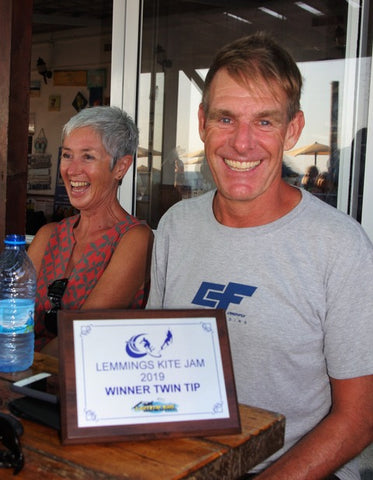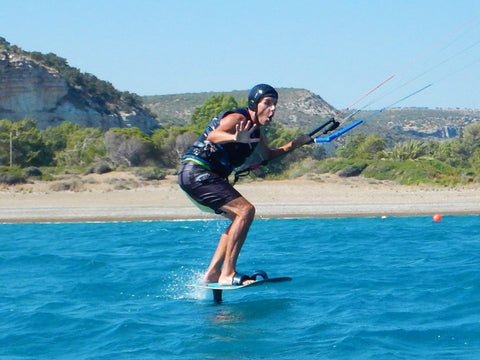
Kitesurfing in Cyprus
Kitesurfing seven days a week, road cycling three times a week, morning SUP sessions when the water is flat, and a generous serve of golf…All in the sunny, beautiful climes of the south coast of Cyprus. Who needs a holiday when retired life is this good?

Steve isn’t exactly hankering to take off anywhere else, that’s for sure. In this series, we catch up with kiters and friends to find out more about where they kite, what it’s like and why they love the sport. Who knows, it might just inspire your next kiting holiday? Here we discover Cyprus with Steve.
Kitesurfing on the south coast of Cyprus
Following his retirement, Steve and his wife left England to set up life in Cyprus, and they’ve not looked back. That said, he doesn’t mind at all taking his kit to other destinations, and has kited comprehensively around the UK, Ireland and France, with trips to Cape Verde, South Africa, Canada and the Canary Islands. Back in Cyprus, he’s a member of the local Lemmings kitesurfing and beach club, which caters largely to the British Forces present on the island and their families. The club has access to a beach that would see at most 20 kiters at any one time. Although just down the road in either direction those numbers can swell up to 70, 80 and beyond during peak season. Their bay is set at the end of a stunning valley, with cliffs on both sides, and about a kilometre stretch of beach in-between.

Kitesurfing conditions in Cyprus
The cross-onshore winds, which arrive more or less without fail every afternoon during summer and often at around 15-20 knots, deliver absolutely perfect conditions. In summer, water temperature reaches the high twenties, and air temperature sits in the low to mid thirties. In winter it wouldn’t get much colder than 16 degrees Celsius during the day, although when the sun goes down the Mercury plummets. That said, kitesurfing in Cyprus in October sees Steve out on the water in boardshorts and a rashie. From November through to April there is more cloud cover and winds arrive from the east. That reliable summer thermal breeze is gone and the kiting community relies instead on pressure systems across the island. He might kite slightly less frequently in winter (a mere three or four times a week), but Steve prefers it during those cooler months as it’s more reminiscent of kiting back in the UK. There’s less of the chop and lumps that summer brings; winter is more about lovely nice waves, making stretches such as the local ‘Ladies Mile’ a real delight.
“So 2005” - the changing face of kitesurfing
About 15 years ago, Steve was a pretty committed windsurfer living in England. He had a good two decades of that sport under his belt when, suddenly, kitesurfers started appearing. He decided to give it a go, and it wasn’t long before he’d bought the essential kit required. In those early days of kiting, the gear understandably wasn’t nearly as advanced as it now is. Kites didn’t have any of the depower they now do, and the safety systems were far inferior. The early models were largely C-Kites without a bridle, so it was all or nothing. The equipment made a pretty honest learner out of you; there was no hiding. Most of the learning happened on a directional surfboard, rather than a twintip, possibly because people just thought that would be easier? In those formative years of the sport, there was not a huge amount of collective experience and knowledge. Everyone was finding their feet, so to speak. No surprises, therefore, that Steve is self-taught.

He looks back on that time as having had a good deal of ‘mistaken arrogance’ - he could windsurf, wakeboard and sail, so surely kiting wasn’t going to be that much of a challenge… It took him some time to realise he was wrong. He got there eventually, but developed plenty of bad habits along the way. He’s been working to rectify these, and a few years ago qualified as a kiting instructor (he is a volunteer BKSA instructor at Lemmings). That, combined with time in a kitesurfing clinic, helped him identify the traits he needed to correct.
Kitesurfing in your 60s and 70s
Now 60, Steve kites with fellow Lemmings club members, some of whom are ten years his senior. They are all really strong, competent kiters, although he confesses they might have all taken a little longer to get to that point compared to the new generation. He is not sure if that’s because this new breed has more access to a greater range of quality equipment, more access to training, or simply youth on their side. It’s probably a combination of all three.

What kitesurf board does Steve ride?
Two, in fact. A strapless surfboard and foil are Steve’s weapons of choice when kitesurfing in Cyprus. He was for some time on the Blade Skinny Boy, but recently added the North Carve to his quiver. He felt like dicing things up a bit, but to be honest he has not noticed a huge difference between the two. He’s more than happy with them both. He’s been on the foil for the last 18 months. One thing is for sure, it’s all a lot easier on the body than windsurfing. It might have taken him a while to demote his first sporting passion, but now he’s well and truly a kitesurfer. Seven days a week, in fact…
